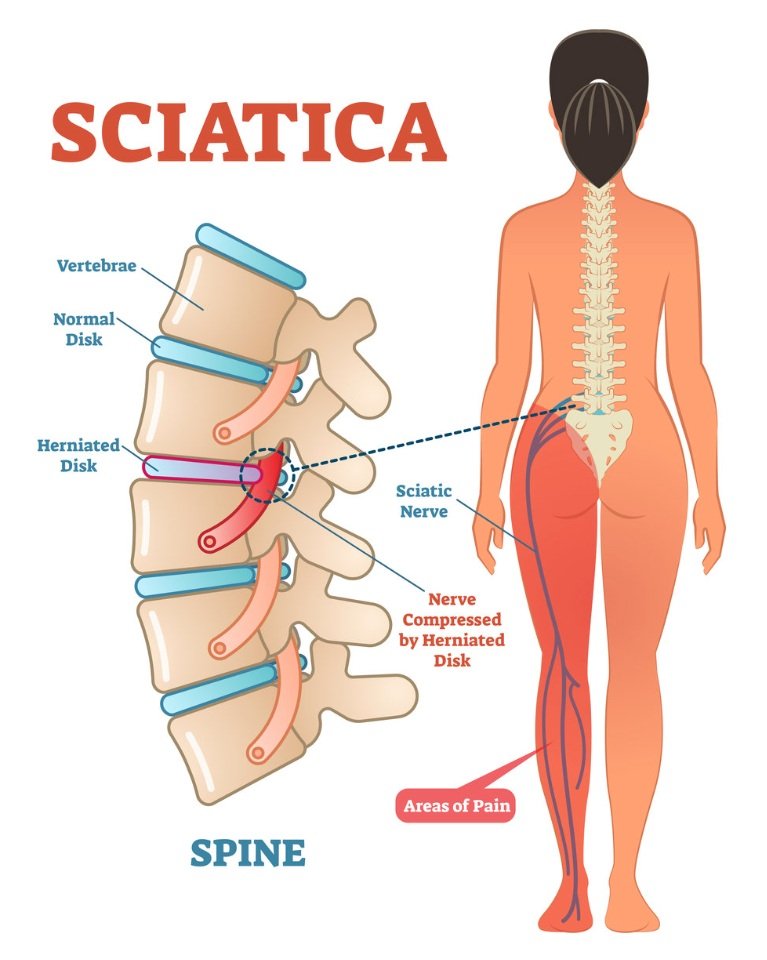Physical Therapy for Sciatica
Sciatica is nerve pain that radiates from the low back through the buttocks and down the length of the leg due to compression of the sciatic nerve. Originating in the low back, the sciatic nerve is most commonly compressed by a herniated or slipped disc causing shooting pain and tingling and numbness through the back and leg. Physical therapy is one of the most effective treatments for sciatica, reducing inflammation, managing and minimizing pain, improving your physical function and mobility, and preventing the reoccurrence of sciatica symptoms.
Anatomy of the Low Back & Sciatic Nerve
The lumbar spine, which comprises the lower back region, extends from just below the rib cage to the upper part of the buttocks and is made up of 5 vertebrae (L1-5). The vertebrae are stacked on top of one another and are separated by discs that act as shock absorbers for the force placed on the spine during movement. The vertebrae and discs are connected by a series of joints, ligaments, and muscles that provide support and mobility in the back.
The sciatic nerve originates in the low back and is the longest nerve in the body. It runs through the pelvic area, passing beside or directly through the piriformis muscle region, branching out of the lumbosacral plexus, a bundle of nerves in the pelvis. It then travels into the buttocks and down the back of both thighs. The sciatic nerve plays an important role in lower body function, providing direct motor function to the hamstrings and lower extremity adductors and indirect motor function to the calf muscles and anterior lower leg muscles.
What is Sciatica?
Sciatica refers to pain that radiates down the path of the sciatic nerve. Pain can begin in the low back and extend through the buttocks and back of the leg. Pain can range from a mild ache to severe, shooting or burning pain. At times, pain may be experienced as an electric shock or lead to tingling, numbness, and muscle weakness in the affected leg. Nearly 40% of people will experience low back pain and sciatica at some point in their lives.
Sciatica is most commonly caused by a herniated or slipped disc that compresses the sciatic nerve. However, sciatica can also develop due to spinal stenosis (narrowing of the spine), trauma to the low back like a car accident, bone spurs from osteoarthritis, spondylolisthesis (the discs of the spine slip forward over the vertebrae below it), degenerative disc disease, broken bones in the thigh or pelvis, or from pregnancy which can loosen ligaments in the low back or stress can be placed on the back due to the baby’s weight and position. A tight piriformis muscle can also irritate the sciatic nerve and compress it, causing pain.
Factors that can heighten the risk of developing sciatica include previous injury and trauma to the lower back, changes in the spine due to age, obesity which can place additional stress on the spine, having a tall height, smoking, pregnancy, diabetes which increases the risk of nerve damage, and occupational and work-related postures or movements, such as jobs that require repetitive heavy lifting or twisting or prolonged sitting.
How Physical Therapy Can Relieve Sciatica Pain
Physical therapy is one of the most effective treatments for sciatica pain management and relief. Physical therapy can reduce inflammation, manage and minimize pain, improve physical function and mobility, and prevent the reoccurrence of sciatica symptoms.
The physical therapist performs a thorough assessment at your first appointment, evaluating your range of motion, posture, reflexes, and movement capacity to determine a baseline assessment of your current condition and how sciatica affects your physical abilities and daily activities. Based on the initial evaluation and testing, the physical therapist designs a customized treatment program tailored to your abilities and goals. Rehabilitation for sciatica pain can range from 4 to 12 weeks depending on the severity of your sciatic pain.
The therapist begins with passive treatments and gentle exercise to help relieve pain and inflammation and prepare the body for active exercise, stretching, and strengthening. Physical therapists utilize a variety of treatments to manage and relieve sciatica pain.
Passive treatments for sciatica pain:
Use of ice and heat to manage pain and inflammation. Heat facilitates more blood to the low back to bring more oxygen and nutrients to the area for healing. Using ice can slow circulation and reduce inflammation, pain, and muscle spasms.
Electrical stimulation using a TENs unit stimulates muscles through variable but safe intensities of electrical current to reduce muscle spasms and increase the body’s production of endorphins, the body’s natural painkillers.
Ultrasound generates sound waves that travel deep into the muscle tissues and create gentle heat to enhance circulation and speed healing.
Manual therapy can involve deep tissue massage and soft tissue mobilizations, targeting the low back muscles and fascia (muscular connective tissue) in the lumbar spine, hips, and buttocks that may be compressing the sciatic nerve.
Dry needling involves inserting thin filiform needles into hyper-irritable taut bands of muscle tissue that may be referring pain and compressing the sciatic nerve.
Active treatments for sciatica pain:
Targeted stretching to increase flexibility and relieve pain in the low back, hips, and legs.
Therapeutic aerobic exercise such as lumbar extension exercises to centralize sciatica pain to the low back and improve overall fitness.
Spinal decompression using traction to relieve pressure on the spine. Traction can be done manually or using a traction machine, which uses weights and pulleys to apply gentle force to tissues surrounding the damaged area and relieve nerve compression.
Resistance training targeting the low back, hip, abdominal, and gluteal muscles to strengthen the spinal column muscles for proper spinal alignment as well as provide a strong base of support to the low back through a stronger core, glutes, and hips.
Aquatic therapy in our warm water therapy pool which not only relieves pain and inflammation in the low back but also helps patients build strength and improve fitness using the gentle resistance of water.
Posture and ergonomics education to protect your spine and minimize aggravating movements and re-injury risk.
Functional retraining for proper technique when lifting, carrying, bending, and squatting.
A recent study evaluated whether an early referral to physical therapy for acute sciatica reduced disability more than usual care alone for patients. The study assessed 220 adults ages 18-60 who were experiencing sciatica for less than 3 months. Those participants in the usual care group were given one session of education on low back pain following a primary care consult, whereas the early physical therapy group was provided an education session and then a referral to 4 weeks of physical therapy that included exercise and manual therapy with the aim of centralizing sciatica symptoms in the low back. The researchers found that those in the physical therapy group experienced greater improvement from baseline to 6 months in terms of decreased disability, greater self-reported treatment success after one year (45.2% in the physical therapy group vs. 27.6% in the usual care group), and had decreased back pain intensity.
Sciatica pain can be debilitating and limit your daily activities and function. Work with our physical therapists to help you manage pain and regain strength and mobility!

